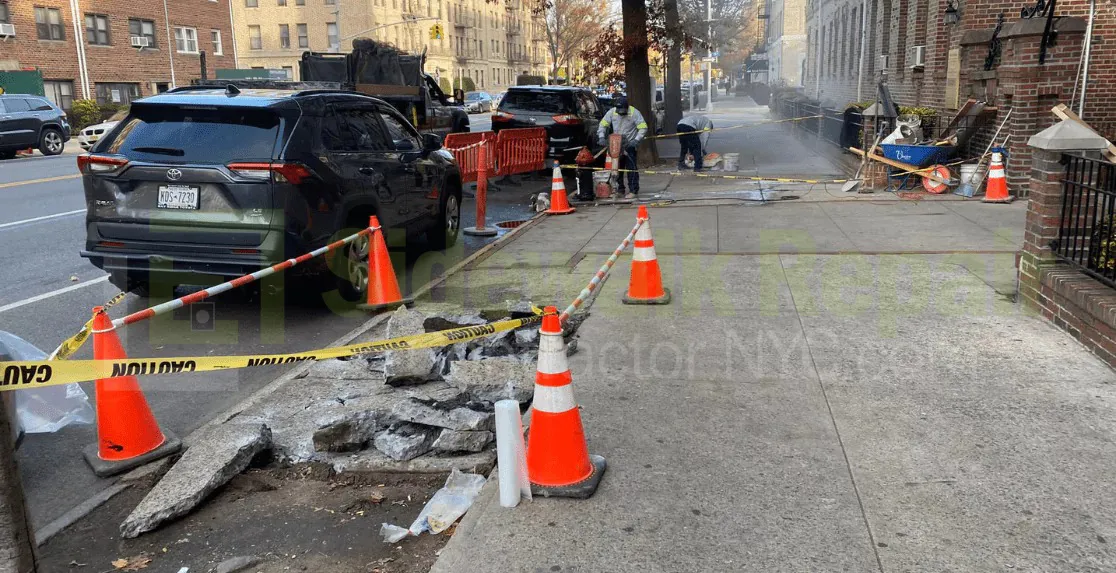
How to Ensure ADA-Compliant Sidewalks for Your NYC Business?
NYC is a busy city, with its streets filled with pedestrians from all around the world. On a random day, you will find local residents rushing to their work, tourists exploring iconic landmarks, and children cycling on the sidewalks.
Extensive public use of the sidewalks requires safe and accessible sidewalks for everyone to use without worrying. Here is where the Americans with Disabilities Act (ADA) comes in.
The ADA has established certain guidelines for businesses to create an inclusive environment for pedestrians. For business owners in NYC, ensuring ADA compliance for your sidewalk is not just a legal requirement; it's the right thing to do.
In this article, we will guide you through ADA sidewalk compliance for commercial property so that you can better understand its importance. Moreover, we will also talk about the importance of hiring professional sidewalk repair contractors in NYC for efficient services.
Why ADA Compliance Matters for Your NYC Business Sidewalk
Beyond the legal obligation, ADA compliance for your sidewalk offers several benefits:
- Allows Accessibility: A well-maintained, accessible sidewalk welcomes everyone, including people with disabilities, promoting a sense of community and social responsibility.
- Reduces Liability Risks: Non-compliant sidewalks pose a trip and fall hazard, potentially leading to lawsuits and hefty settlements.
- Enhances Customer Experience: A smooth, accessible sidewalk ensures a positive experience for all your customers, regardless of their abilities. It can result in increased customer loyalty and positive word-of-mouth marketing.
ADA Sidewalk Requirements By New York City
The ADA outlines specific guidelines for sidewalk design and maintenance to ensure accessibility. Here are some key requirements of the ADA for NYC businesses:
- Curb Ramps: Every accessible route leading to or from your business entrance must have a curb ramp that meets specific slope and width requirements. It allows people using wheelchairs to easily navigate the transition from sidewalk to street.
- Clear Width: The accessible path on your sidewalk must have a minimum clear width of 36 inches. It allows people to use wheelchairs and other disability aids in an efficient way.
- Surface Conditions: The sidewalk surface should be stable, firm, and slip-resistant. Uneven surfaces, cracks, or objects on sidewalks can create trip hazards.
- Signage: Signage indicating accessible entrances or exits might be required depending on your business type and location.
Sidewalk Assessment for ADA-Compliance
Before repairing or modifying your sidewalks for ADA-compliance, a thorough assessment of your sidewalk for ADA compliance is crucial. Here is how you can assess your sidewalks.
- Visual Inspection: Start by visually inspecting your sidewalk for any cracks, uneven slabs, trip hazards, or obstructions that might hinder accessibility.
- Measure Up: Use a measuring tape to ensure the clear width on your sidewalk meets the minimum 36-inch requirement.
- Curb Ramp Check: Evaluate the presence and functionality of curb ramps at all access points. Ensure they comply with the proper slope and width specifications.
- Consult Professional Contractors: Don't hesitate to consult with sidewalk contractors for a professional evaluation, particularly for commercial sidewalks.
Repair Solutions to Address Non-Compliance
If your sidewalk assessment reveals non-compliance issues, here are some resources and solutions to help you get your sidewalk ADA compliant:
- The NYC Department of Transportation (DOT): The NYC DOT plays a crucial role in sidewalk maintenance and accessibility. They offer a wealth of information on ADA compliance requirements and resources for repairs. You can visit their website or call them for guidance.
- NYC Department of Buildings (DOB): The DOB might be involved in sidewalk repairs requiring permits or structural modifications. Consulting with the DOB ensures your repairs comply with all necessary building codes and regulations.
- Licensed Sidewalk Repair Contractors: Hiring a licensed and insured NYC sidewalk repair contractor with experience in ADA compliance is recommended. They can assess the damage, recommend the most suitable repair method to address non-compliance issues, and obtain the necessary permits.
Common ADA Sidewalk Repairs for NYC Businesses
Some common sidewalk repairs that you might need to achieve ADA compliance in NYC. Let us have a look at them one by one.
- Curb Ramp Installation or Repair: If a curb ramp is missing or non-compliant, professional installation or repair provides safe and accessible sidewalks for everyone to use.
- Crack Filling and Slab Leveling: Uneven slabs or cracks create trip hazards. Crack filling and slab leveling techniques restore a smooth, even surface.
- Sidewalk Replacement: In severe cases of damage or when existing materials pose accessibility challenges (e.g., cobblestones), complete sidewalk replacement with ADA-compliant materials might be necessary.
Conclusion
ADA-compliant sidewalks are safe and accessible for everyone to use, especially people with disabilities. If you want to make your sidewalks safe and accessible for everyone to use, you can reach out to a professional sidewalk repair contractor in NYC. Professionals have the licensing and experience to provide ADA services and make your sidewalks accessible for everyone to use.